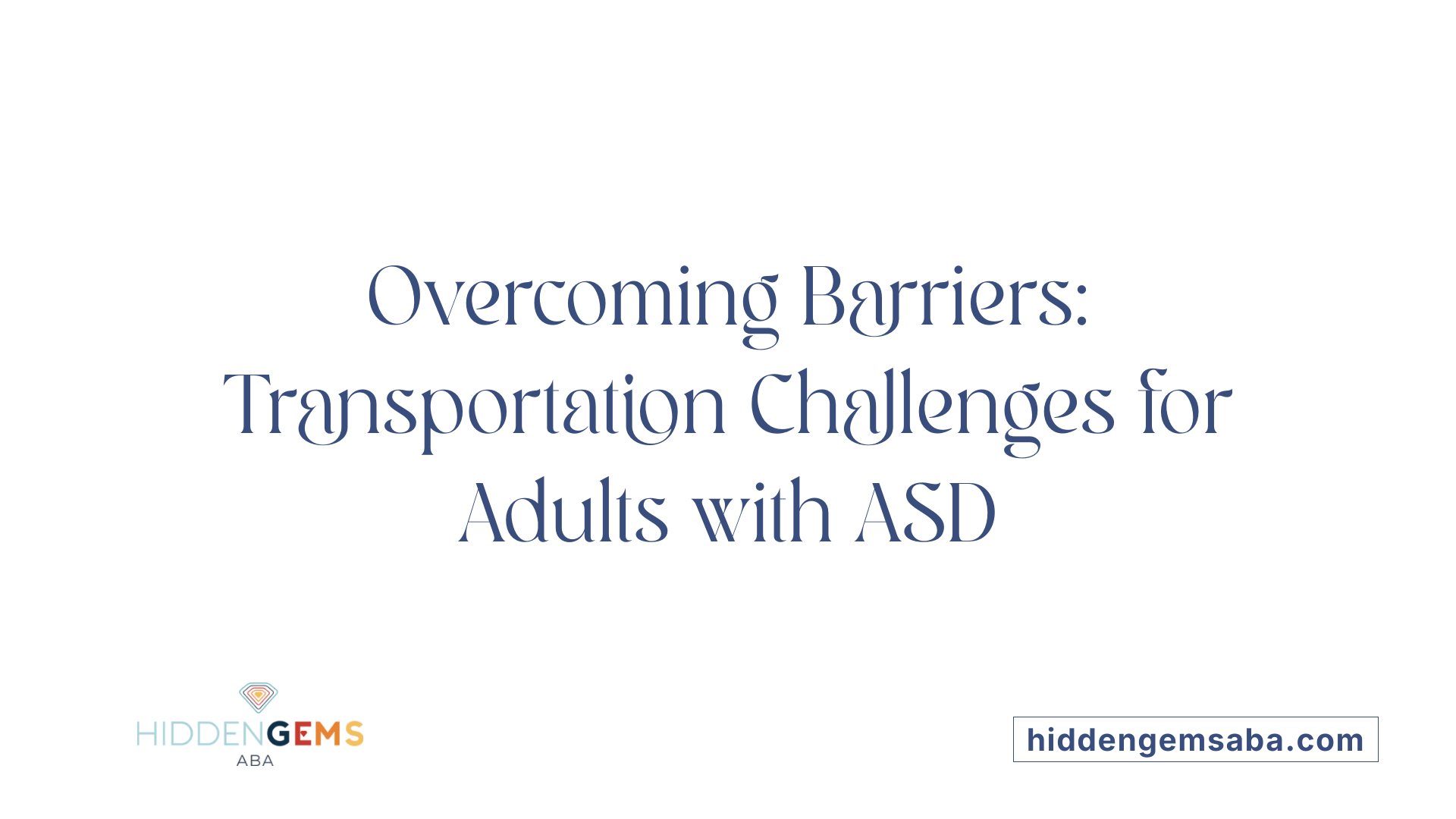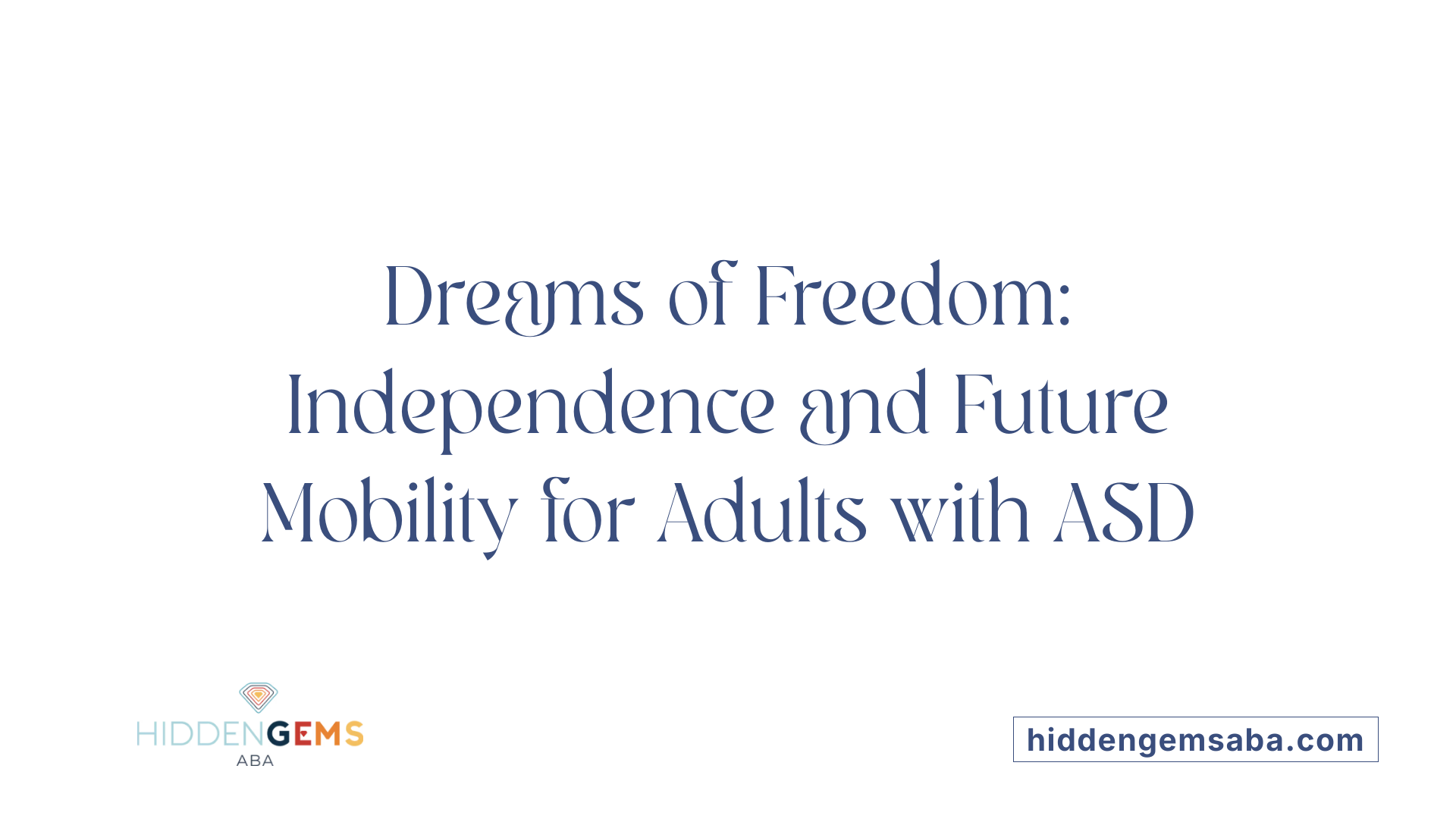Understanding the Intersection of Autism and Transportation
Transportation poses unique and significant challenges for individuals with autism spectrum disorder (ASD), influencing their access to healthcare, employment, and community engagement. With an estimated 1.5 to 3.5 million Americans on the spectrum, and about half a million transitioning into adulthood in the coming decade, understanding these obstacles is critical. This article explores the multifaceted transportation difficulties faced by adults with ASD, related behavioral therapies, and emerging solutions aimed at fostering independence and improving quality of life.
Behavioral Analysis Therapy: Foundations for Supporting Autism Transition Challenges
What is behavioral analysis therapy for autism?
Behavioral analysis therapy, widely known as Applied Behavior Analysis (ABA), is a scientifically supported approach designed to improve adaptive skills in individuals with autism spectrum disorder (ASD). ABA assesses behavioral patterns and environmental influences to promote desired behaviors through techniques such as positive reinforcement, prompting, and analyzing antecedents and consequences. Modern ABA programs are tailored to each individual's needs and often integrate naturalistic and functional methods. This therapy emphasizes essential skills for independence, including communication, social interaction, and self-care.
Role of ABA in skill development related to transportation independence
For many adults with ASD, transportation presents significant challenges due to sensory sensitivities and unfamiliar environments. ABA interventions can support transportation independence by teaching crucial skills like navigating public transit systems, understanding schedules, and managing sensory triggers. Through systematic instruction and positive reinforcement, ABA helps individuals develop travel skills needed to reduce reliance on family or friends, enhancing their confidence and autonomy. Programs like travel training curriculums often incorporate ABA techniques to improve community mobility.
Key principles guiding ABA interventions
ABA relies on several foundational principles:
- Positive reinforcement: Encourages repetition of helpful behaviors by rewarding progress.
- Antecedent-Behavior-Consequence (ABC) analysis: Identifies and modifies environmental triggers and outcomes to shape desired actions.
- Individualized treatment: Customized plans developed after thorough behavioral assessments.
- Data-driven decisions: Regularly collecting data to monitor progress and adjust strategies.
Guided by qualified behavior analysts, these principles help target functional skills including social communication and daily living activities necessary for adults with ASD to gain greater independence, such as using public transportation or obtaining a driver's license.
Who Provides Behavioral Analysis Therapy and Its Role in Transportation Skill Building?

Who provides behavioral analysis therapy for autism?
Behavioral analysis therapy for autism is primarily provided by certified professionals called Board Certified Behavior Analysts (BCBAs). These individuals have specialized training to develop and oversee Applied Behavior Analysis (ABA) programs. They work in various settings, including clinics, schools, and homes, ensuring therapy is tailored to each individual's unique needs.
Besides BCBAs, trained therapists and technicians often assist in delivering the therapy under BCBA supervision. These teams use evidence-based techniques focusing on positive reinforcement to improve communication, social skills, and daily living abilities.
How do professionals target transportation-related skills?
Behavior analysts and therapists design specific lessons to teach transportation skills crucial for independence. These include recognizing bus stops, understanding schedules, managing sensory challenges, and safely navigating routes. Structured training programs, like travel training curricula, are used to gradually build confidence and competence in public transit use.
What roles do therapists, behavior analysts, and families play collaboratively?
Successful transportation skill building relies on close collaboration. Therapists and behavior analysts develop and implement customized plans while involving families to practice skills in real-life contexts. Families provide ongoing support and reinforcement, helping adult individuals with autism generalize these skills in their communities. This teamwork ensures that transportation independence translates into improved access to healthcare, employment, and social participation.
Transportation Challenges Faced by Adults with Autism Spectrum Disorder

What is the scope of the transportation problem for adults with ASD?
Approximately 1.5 to 3.5 million Americans are affected by autism spectrum disorder (ASD). Within the next decade, around half a million of these individuals will transition into adulthood, facing growing transportation challenges. Up to 80% of adults with ASD rely heavily on friends or family for transportation, underscoring a significant lack of independent travel skills.
What are the common barriers related to transportation for adults with ASD?
Adults with ASD often experience sensory processing differences that can trigger anxiety in busy or stimulating environments commonly found in public transportation. Additionally, public options like paratransit face limitations such as scheduling difficulties and environmental hurdles. These factors, combined with unfamiliarity and high costs of transportation, create formidable barriers.
Parents and guardians also express concern about their adult children's safety when using public transit, leading many to act as primary transportation providers. This situation imposes emotional and financial strains on families.
How does transportation impact employment, healthcare access, and social participation?
Transportation barriers affect adults with ASD by limiting access to vital community services, healthcare, and job opportunities. The lack of reliable independent travel options restricts social participation and personal autonomy.
However, many adults with ASD desire independence through learning to use public transportation or obtaining a driver's license. Such mobility improvements could increase employment prospects and community involvement.
Additional efforts to address these challenges
Travel training programs like the "Chance to Ride" curriculum aim to teach navigation of public transit systems, enhancing community mobility. Peer-mediated travel training, involving peers as role models or trainers, shows promise by fostering trust and empowerment, which may lead to greater independence and self-efficacy among adults with ASD.
Emotional and Financial Impact on Families Providing Transportation Support

The role of parents and guardians as primary transport providers
For many adults with autism spectrum disorder (ASD), parents and guardians play a crucial role as the main source of transportation. About 80% of adults with ASD depend heavily on friends and family for travel, illustrating a significant gap in independent transportation options. This reliance often means that caregivers must adjust their schedules and daily routines to meet the mobility needs of their loved ones.
Concerns about safety and independence
Parents of adults with ASD frequently express worries related to the safety of their children when using public transportation. The sensory processing differences common among people with ASD can cause heightened anxiety in crowded or noisy transit environments, making independent travel challenging. Consequently, guardians may be hesitant to encourage public transport use without adequate support or training programs.
Emotional stress and financial burdens families face
The responsibility of being the primary transportation provider places both emotional and financial strains on families. Beyond the time and energy commitment, the costs associated with travel—including fuel, vehicle maintenance, or alternative transport services—can add up significantly. Emotional stress also stems from concerns over their adult child’s autonomy, balancing the desire for their independence with the need for safety and support. These combined pressures highlight the critical need for improved transportation solutions and training programs to empower adults with ASD and alleviate family burdens.
Innovative Travel Training Programs Enhancing Independence

What Are Travel Training Initiatives Like 'Chance to Ride'?
Travel training programs are designed to teach individuals with autism spectrum disorder (ASD) how to effectively use public transportation. One notable example is the 'Chance to Ride' curriculum, which offers structured lessons on navigating transit systems, understanding schedules, and managing trip planning. These initiatives aim to increase community mobility and reduce reliance on family or friends for transportation.
How Does Peer-Mediated Travel Training Work and What Are Its Benefits?
Peer-mediated travel training involves peers serving as trainers or role models for adults with ASD learning to use public transit. This approach leverages trust and relatable social interactions to facilitate learning. Peers not only provide companionship but also demonstrate practical skills in real-life transit environments, helping to lower anxiety associated with sensory sensitivities common in adults with ASD.
What Evidence Supports Empowerment and Learning Outcomes Through Peer Involvement?
Research shows that peer involvement boosts feelings of empowerment and enhances learning outcomes for individuals with ASD. The presence of familiar peer trainers can increase confidence, promote self-efficacy, and encourage greater participation in community activities. These positive effects potentially translate into improved independence and employment opportunities by overcoming transportation barriers.
Together, these travel training programs and peer-mediated strategies present promising avenues to address transportation challenges faced by adults with autism, fostering safer and more independent travel experiences.
The Desire for Independence and Its Implications for Future Mobility

Adults with ASD Seeking Driving Licenses and Public Transit Use
Many adults with autism spectrum disorder (ASD) express a strong desire to achieve independence by learning to use public transportation or obtaining a driver's license. This goal reflects their wish to navigate their communities without relying heavily on friends, family, or caregivers for transportation. However, multiple barriers such as sensory sensitivities and unfamiliar environments make these aspirations challenging to fulfill. Despite these obstacles, programs focused on travel training, including peer-mediated instruction, are helping adults with ASD gain confidence and skills to manage their transportation needs independently.
Connection Between Independent Transportation and Employment Opportunities
Access to reliable, independent transportation plays a crucial role in expanding employment opportunities for adults with ASD. Without the ability to travel independently, many face difficulties attending jobs or vocational training, limiting their economic and social participation. Obtaining a driver's license or confidently using public transit can remove these barriers, enabling adults with ASD to pursue employment that aligns with their interests and abilities. This autonomy not only improves their financial independence but also enhances their sense of self-efficacy and community integration.
Potential Community and Quality-of-Life Improvements
Improved transportation independence has far-reaching benefits beyond employment. It enables adults with ASD to access healthcare, educational activities, social events, and community services more easily. This increased mobility can lead to better health outcomes, enhanced social connections, and a higher overall quality of life. As independence grows, the emotional and financial burdens on parents and guardians often lessen, fostering a more balanced family dynamic. In essence, supporting adults with ASD in achieving transportation independence opens doors to fuller participation in society and a more empowered life.
Towards Inclusive Mobility: Embracing Solutions for Adults with Autism
Transportation remains a formidable barrier to independence and community integration for adults with autism spectrum disorder. While behavioral analysis therapy serves as a foundational tool in fostering essential skills, the journey towards accessible and reliable transportation options requires broader systemic adaptations. Innovations such as travel training programs and peer-mediated approaches offer promising pathways to enhance confidence and competency in navigating public transit. Addressing sensory challenges and developing supportive infrastructure can alleviate familial burdens and unlock employment and social opportunities for adults with ASD. Collective efforts between therapists, transportation authorities, families, and communities are essential to create inclusive mobility solutions, empowering adults on the autism spectrum to move freely and participate fully in society.
References
- Transportation Issues of Adults on the Autism Spectrum
- Effectiveness of a peer-mediated travel training ...
- Applied Behavior Analysis (ABA)
- Applied Behavior Analysis (ABA)
- The Controversy Around ABA
- Applied Behavior Analysis (ABA)
- Treatment and Intervention for Autism Spectrum Disorder
- Applied Behavior Analysis (ABA)






